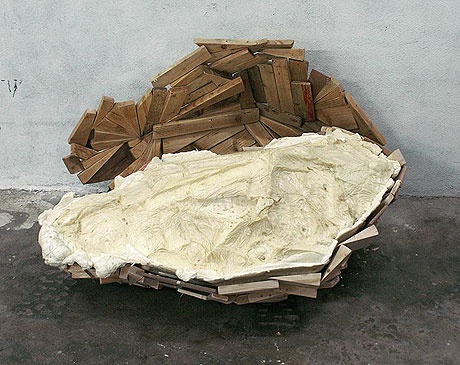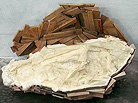replikantki (2) — cieplarniane warunki — Natalia Bażowska, Kinga Bella, Magdalena Starska, Tatiana Wolska

„Replikantki” to cykl wystaw w Małej Przestrzeni prezentujący twórczość młodych polskich artystek. Tytułowe określenie ma wpisany w siebie rewolucyjny potencjał, generowanie nieznanych wartości, odwracanie przeciwko systemowi, który je stworzył. Miarą prawdziwości przywołanych historii staje się niezgoda na sformatowanie do racjonalnych ram i sztywnych, logicznie uzasadnionych podziałów, potrzeba mocnego upodmiotowienia kobiety-autorki w strategiach lektury. Odkrywanie sensu tkwiącego w szczególe staje się bazą do stworzenia nowego języka, w którym artystki nie występują w roli outsiderów, ale znajdują miejsce dla mówienia o sobie, w pewnym przesunięciu do obowiązującego fallogocentrycznego porządku. Sięgając do intymnych doświadczeń zatracają się w tekstach, rozłożone w toksycznych wydzielinach własnej sieci.

„Replikantki” — intymne przekazy artystek (teksty, prace, idee) skumulowane w publikacji Książka została zaprojektowana jako dokumentacja cyklu wystaw, który odbywał się w Galerii Sztuki Współczesnej BWA w Katowicach w...

replikantki (4) — język do lizania — Justyna Gruszczyk i Bianka Rolando Joseph Beuys w jednej ze swoich legendarnych akcji szepce coś do ucha martwego zająca, którego nosi na rękach. Nie wiadomo co mówi. Zgodnie...

replikantki (3) — minimalne poprawki — Alicja Karska i Aleksandra Went Prace Aleksandry Went i Alicji Karskiej wydają się oporne w swojej prostocie, szczelnie zamknięte. Tak jak w przypadku snów, co do...

replikantki (1) — znieczulenie — Dorota Buczkowska „Lilith”, „Interror”, … Znieczulenie znosi świadomość, ból i odruchy obronne. Jako zabieg wynika z potrzeby utwardzania, ochrony przed zbyt intensywnymi doznaniami....

Drążenie autorskich wizji oprócz precyzyjnych narzędzi wymaga cierpliwości i uwagi, jeśli lektura jest przeprowadzana z biegu wytraca sens. Cieplarniane warunki przygotowują kokon dla wyobraźni, skraplają kiełkujące pomysły, ogrzewają je i chronią. Zostawiają pole do eksperymentu, w które wpisane jest ryzyko błędu i nieoczekiwanych rezultatów. Zapewniająca je wylęgarnia ma w sobie coś z gabinetu osobliwości, alchemicznego studia, laboratorium, terrarium. Kojarzy się z ograniczeniami wstępu zapewniającymi nienaruszalny stan, który sprzyja zachodzącym zmianom. Wejście do niej za każdym razem wymaga zresetowania i przygotowania do zatopienia w świecie rządzącym się własnymi zasadami.
Odwrócenie od rzeczywistości w przypadku twórczości zaproszonych artystek poskutkowało przebitką z lunatykowania po lesie, traceniem oddechu pod wodą, chwilową utratą przytomności, oślepieniem po wpatrywaniu się w słońce. Ich prace z wpisaną w siebie ruchliwością przypominają coś zmiętego i nieuformowanego. Są zawieszone w fazie powstawania, bagienne, ciastowate, ciągnące się. Zaludniające je galaretowate postaci z prywatnego bestiarium artystek działają według tymczasowej mitologii. Pozostając na najbardziej prymitywnym stopniu organizacji, poza prawem i porządkiem zatrzymują się w połowie drogi między męskim, a żeńskim, w przerwanym stadium larwalnym.
W cieplarnianych warunkach można bez odpowiedzialności i jakiegokolwiek planu działania przyglądać się temu, co dopiero się wyłania. Wrócić do oczyszczającego stanu bez formy, gdzie rozbudowujące się struktury są bardzo kruche. Szybko zmieniają kształty i rozpadają w mgnieniu oka, jak większość niewykrystalizowanych sytuacji i mglistych postaci, mając w sobie szczególną siłę.
Kuratorka: Marta Lisok





